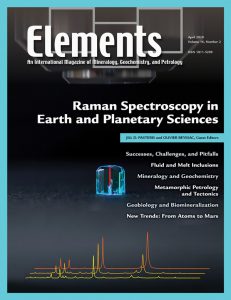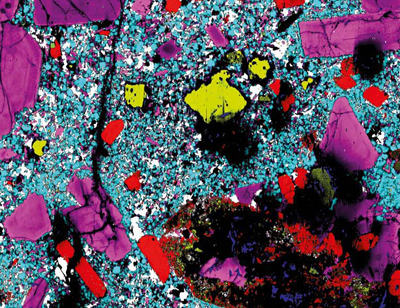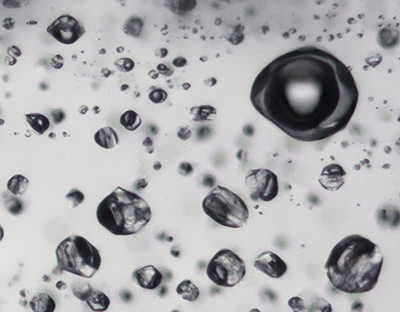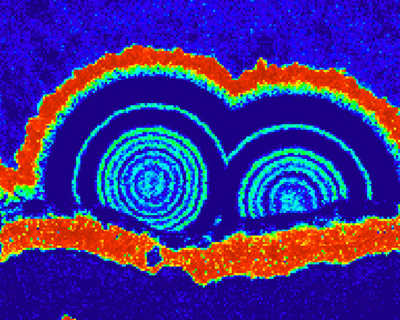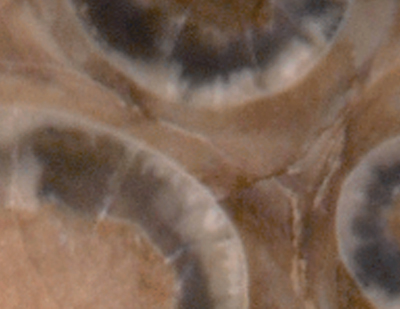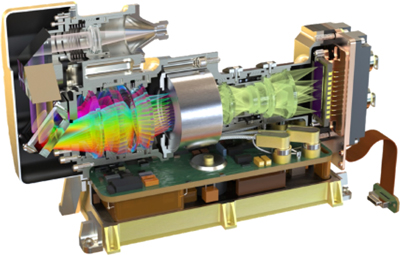Raman Spectroscopy in Earth and Planetary Sciences
Jill D. Pasteris and Olivier Beyssac – Guest Editors
Table of Contents
The application of Raman (microprobe) spectroscopy in the geosciences has rapidly broadened and deepened over the past 40 years. This has been sparked by both improvements in technology and recognition of the quantitative, as well as qualitative, capabilities of the technique. Raman spectroscopy claims relative ease of use; is typically nondestructive at the (sub-)micrometer scale; has the ability to analyze solids, liquids, and gases; can differentiate polymorphs; and can enlarge the available spectral databases for minerals especially. Petrologists, geologists, mineralogists, geochemists, and geobiologists can create Raman maps/images based on selected spectral features, which simultaneously capture chemical–structural and microtextural information. In a single sample, one may investigate quantitatively the P–T path history during metamorphism, determine the composition and internal pressure of mixed volatiles in micrometer-size fluid inclusions, study the strain pattern or radiation damage in minerals, and/or target possible biosignatures.
- Welcome to Raman Spectroscopy: Successes, Challenges, and Pitfalls
- Microscale Chemistry: Raman Analysis of Fluid and Melt Inclusions
- Applications of Raman Spectroscopy in Mineralogy and Geochemistry
- Applications of Raman Spectroscopy in Metamorphic Petrology and Tectonics
- Geoscience Meets Biology: Raman Spectroscopy in Geobiology and Biomineralization
- New Trends in Raman Spectroscopy: From High-Resolution Geochemistry to Planetary Exploration
Bruker
Excalibur Mineral Corporation
Dr. Henry A. Hanni
International Mineralogical Association
Materials Research Society
ProtoXRD
Savillex
WITec
v16n3 Redox Engine of Earth
GUEST EDITORS: Roberto Moretti (Observatoire Volcanologique et Sismologique De Guadeloupe, IPGP, Guadeloupe, French West Indies), M. Rita Cicconi (Universität Erlangen-Nürnberg, Germany), and Daniel R. Neuville (Institut de Physique du Globe Paris, France)
The redox state is one of the master variables that drove the formation of the Earth and that now also controls life processes. From the dawn of geochemistry, a knowledge of redox states has been essential to understanding the compositional makeup of our planet and the fundamental processes that occur in any natural chemical system, from the core to the atmosphere, from magmatic systems to aquatic systems. The social and economic impact of redox geochemistry is enormous because of the control it plays on metal mobility, solubility, metal availability and any associated complexing ligands, and the widespread use of redox indicators for environmental hazard assessment. This issue of Elements will illustrate how understanding redox processes can help us to understand much of Earth’s activity.
- Earth’s Electrodes M. Rita Cicconi (Universität Erlangen-Nürnberg, Germany), Roberto Moretti (Observatoire Volcanologique et Sismologique De Guadeloupe, IPGP, Guadeloupe, French West Indies) and Daniel R. Neuville (Institut de Physique du Globe Paris, France)
- Redox Processes in Early Earth Accretion and in Terrestrial Bodies Kevin Righter (NASA Johnson Space Center, USA), Christopher D. Herd (University of Alberta, Canada), and Asmaa Boujibar (Carnegie Institution for Science, Washington DC, USA)
- The Redox Boundaries of Earth’s Interior Yingwei Fei (Carnegie Institution for Science, Washington DC, USA) and Vincenzo Stagno (Sapienza Università di Rome, Italy)
- Magma: the Largest Repository and Carrier of Earth’s Redox Processes M. Rita Cicconi (Universität Erlangen-Nürnberg, Germany), Charles Le Losq (Australian National University, Australia), Roberto Moretti (Observatoire Volcanologique et Sismologique De Guadeloupe, IPGP, Guadeloupe, French West Indies), and Daniel R. Neuville (Institut de Physique du Globe Paris, France).
- Volcanic and Geothermal Redox Engines Roberto Moretti (Observatoire Volcanologique et Sismologique De Guadeloupe, IPGP, Guadeloupe, French West Indies) and Andri Stefansson (University of Iceland, Iceland)
- Electron Transfer Drives Metal Cycling in the Critical Zone Mélanie Davranche (Université de Rennes 1, CNRS, France), Alexandre Gélabert (Institut de Physique du Globe Paris, France), and Marc F. Benedetti (Institut de Physique du Globe Paris, France)
- Biogeochemical Controls on the Redox Evolution of Earth’s Oceans and Atmosphere Christopher T. Reinhard (Georgia Institute of Technology, USA) and Noah J. Planavsky (Yale University, USA)
- Abiotic Hydrogen and Hydrocarbons in Planetary Lithospheres (February 2020)
- Raman Spectroscopy in the Earth and Planetary Sciences (April 2020)
- The Redox Engine of Earth (June 2020)
- Lithium: Less is More (August 2020)
- Noble Gas Thermochronology (October 2020)
- Hydrothermal Fluids (December 2020)



